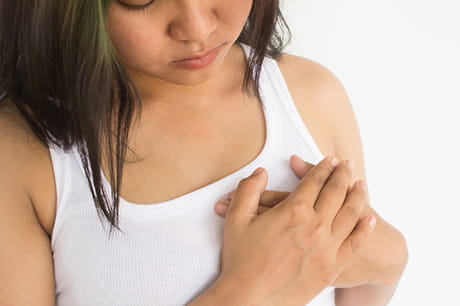A change in your breast may be an early sign of breast cancer. Here’s what to look for.
When people think about breast cancer detection, they usually think about finding a lump in one of their breasts. A lump is a possible sign of breast cancer, but it isn’t the only one — and it may not be the first sign to develop.
Breast cancer affects approximately one in eight women in their lifetime. But today, breast cancer is becoming more and more treatable — especially when it’s caught early.
“There are a few signs and symptoms to watch out for,” says Mona Duncan, MD, general surgeon at Geisinger. “That’s why it’s so important to go for your regular checkups and mammograms, and to perform monthly breast self-exams at home.” Learn how to perform a breast self-exam.
Early signs of breast cancer
While performing breast self-exams, keep an eye out for these early warning signs of breast cancer. If you notice any of these signs (or any abnormal changes), make an appointment with your doctor right away.
1. Visible changes in the nipple or skin
After puberty, your nipples remain fairly consistent in shape, size and color. Generally, there shouldn’t be any sudden changes with your nipples or skin. But if there are any visible changes, such as a red, itchy or scaly rash; inversion or sucking-in of the nipple; dimpling, puckering or other changes in the skin on or around the nipple, you should see your doctor.
“As breast cancer progresses, it grows and pushes other things out of the way,” Dr. Duncan says. “This can cause changes in the breast, skin and nipple as the breast’s internal structure changes.”
2. Swelling
Especially during menstruation, your breasts may become tender or swell. This is completely normal. However, if you notice that the tenderness and swelling is abnormal, discolored or lasts longer than a week, let your doctor know.
“If you have persistent swelling in your breasts, it’s a good idea to go see your doctor,” says Dr. Duncan. “Swelling is your body’s version of an alarm, telling you that something is going wrong. In this case, the breast cancer could be irritating or blocking normal breast function, so it would cause it to swell. Lumps by themselves are usually not painful, but they can sometimes cause swelling that is.”
3. Nipple discharge
Discharge from the nipple, while not always a cause for immediate concern, should be monitored and evaluated by a doctor, especially if it’s a new symptom for you.
Is the discharge bloody, clear or milky? Does it happen even without the nipple being squeezed? Is it only coming from one breast?
“Discharge can be caused by a few different things, and it isn’t an extremely common symptom of breast cancer,” says Dr. Duncan. “But it’s still a good idea to get it checked out by your doctor.”
What to do if you spot a possible sign of breast cancer
Don’t panic. If you notice a change in your breast, it doesn’t necessarily mean you have breast cancer. “Some of these changes may be a result of benign, or non-cancerous, breast conditions,” explains Dr. Duncan.
Still, if you notice any change at all, especially one occurring in only one breast, it’s a good idea to contact your doctor to get treatment started right away, if necessary.
Next steps:
Learn more about Mona Duncan, MD
Not sure how to perform a breast self-exam? Here’s how
Not sure what to expecting during a mammogram? Find out


